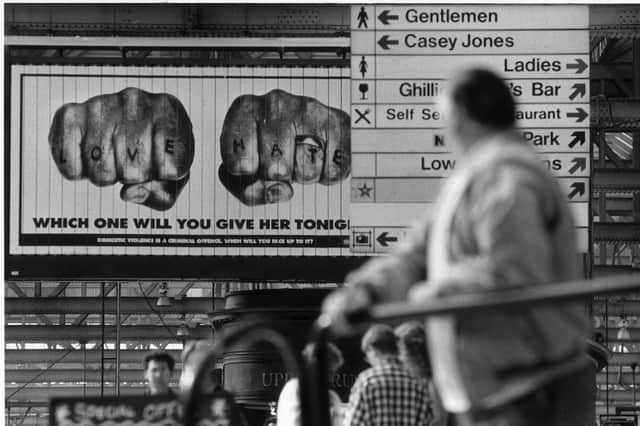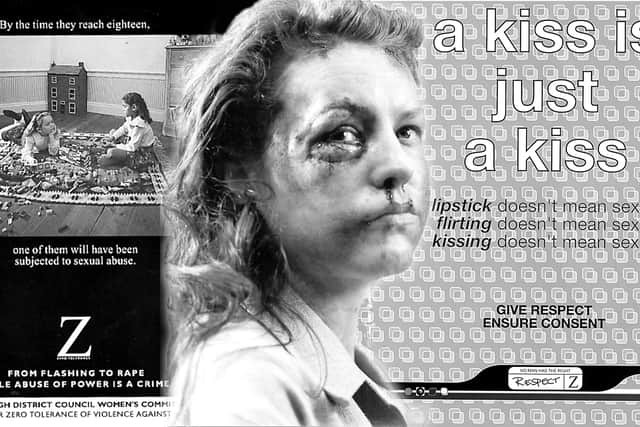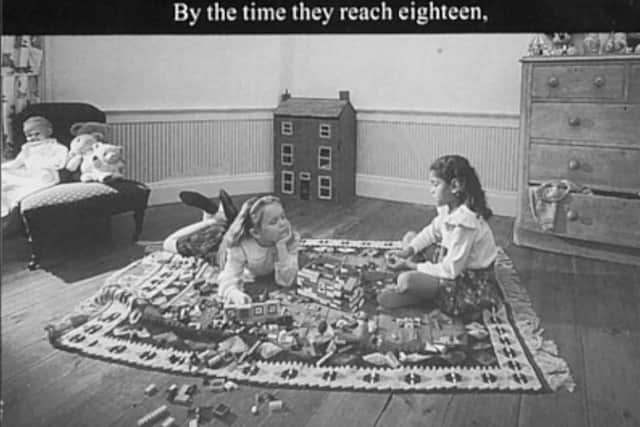Zero Tolerance: 30 years on from landmark campaign against rape and violence, women are still fighting many of the same battles – Kirsty Strickland


White typeface on a solid black background. The first line reads, “Whoever, wherever, whenever.” The second, “Sexual assault – there is no excuse.”
This poster was part of a ground-breaking 1992 Zero Tolerance campaign devised by Evelyn Gillan, and it forever changed Scotland’s perceptions of violence against women.
Advertisement
Hide AdAdvertisement
Hide AdThe six-month campaign was designed in such a way that it couldn’t be ignored. The startling black and white posters were put up in council buildings and shops and handed out in pubs and libraries. It came at a time when rape within marriage had only been made illegal a few years previously and domestic abuse was still widely viewed as a private matter between spouses.
Unflinchingly bold
It was bold because it needed to be. This was an unflinching campaign that challenged the idea that domestic violence was a working-class affliction or something that women should be blamed for in some way provoking.
Underneath photographer Franki Raffles’ images of happy, affluent domestic scenes were sobering straplines. One photo, of a grandmother and a young girl cuddled up reading a book, read ‘’From three to ninety-three – Women are raped.’’


In trying to combat the attitudes that allowed violence against women to flourish, the group commissioned a survey of young people to gauge their perceptions of it.
Their 1998 survey of more than 2,000 young people in Glasgow, Fife and Manchester found that one-third of girls and half of boys thought hitting or raping a woman was OK in certain circumstances.
Today, Zero Tolerance is one of Scotland’s leading women’s charities. It still exists, because, sadly, it still needs to.
I thought of Zero Tolerance and its radical beginnings when I read the results of the recently published Scottish Societal Attitudes Survey.


First, the good news. The majority of people agreed that rape is “very seriously wrong”, and that it causes “a great deal” of harm.
An enduring myth
Advertisement
Hide AdAdvertisement
Hide AdHowever, people thought that rape is less wrong and less harmful in the context of a marriage than when it is perpetrated by a stranger.
We can see how harmful victim-blaming is when we look at how those figures change if the woman first takes the man into the bedroom and kisses him. In that scenario, people saw the rape as less wrong.
Here, the proportion of people who said the rape was "very seriously wrong” fell from 91 to 67 per cent for a man raping a woman he just met at a party, and from 84 to 55 per cent for a man raping his wife.
This isn’t at all surprising. One of the most enduring of all rape myths is surely that of the ‘perfect’ victim. As the survey shows, most people think that rape is wrong. But when you add in factors such as what she was wearing, if she was drunk and whether she knew her attacker, sympathy and understanding starts to wane.
Three in ten people thought that a woman is at least partly to blame for being raped if she is either very drunk or wearing revealing clothing. Twenty-eight per cent of people said that rape results from men being unable to control their need for sex.
Gender stereotypes
We cannot separate statistics like these with the, at times, hostile environment victims experience when they decide to report. And we cannot separate that hostility – which many survivors describe as worse than the rape itself – with the shockingly low reporting and conviction rates for sexual violence in Scotland.
One set of questions in the violence against women module of the survey asks about gender stereotypes in children. It seems an odd inclusion.
What relevance does dolls for boys and trucks for girls have here, nestled in-between questions about attitudes to rape and domestic abuse?
Advertisement
Hide AdAdvertisement
Hide AdThe answer is that gender stereotypes have an impact on how we view women’s inequality of safety. The survey found that “overall, people who held these stereotypical views on gender roles were less likely to see abusive behaviour as wrong and harmful”.
It’s obvious how widespread these gender stereotypes are when you walk into a toyshop and see the great blue and pink divide stretching out in front of you.
Is it any wonder that 41 per cent of people said that they would either try and change the mind of a three-year-old boy who wanted a princess doll or make him put it back when the sex-segregation of toys is so widespread?
Unicorn princesses and future spacemen
That’s before you even get onto the clothes. Next time you are in a supermarket, have a look at the slogan t-shirts in the children’s clothing section.
You can be sure that the majority of the phrases written on girls' clothes will be a variation of “be nice”, “smile and be happy” and “sparkly unicorn princess”. Over in the boys' section, you’ll see “boss”, “legend”, “future spaceman”.
These are the kind of small-scale annoyances that, on their own, sound like much ado about nothing. First world problems, if you like. “PC gone mad’” if you are so inclined.
But the results of the societal attitudes survey show us that when it comes to tackling the scourge of violence against women, attitudes matter as much as actions.
Thankfully, we are making progress. The proportion of people who held stereotypical views on gender roles declined from 2014 to 2019, as did belief in rape myths.
Advertisement
Hide AdAdvertisement
Hide AdThe findings will be included in the Scottish government’s Equally Safe Delivery Plan, and help inform future work to tackle violence against women and girls.
I wonder how the Zero Tolerance group from 1992 would have felt if they had known that the posters they designed to shock a city into action would still be relevant nearly 30 years on. Or that women now would still be fighting many of the same battles they were then.
